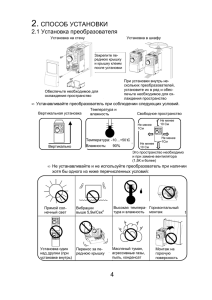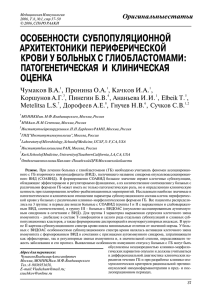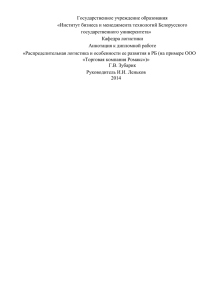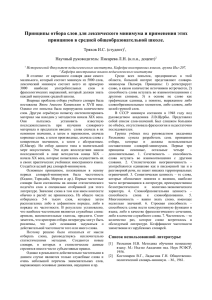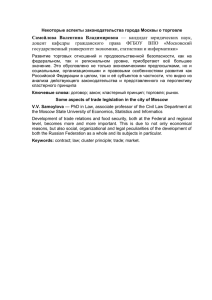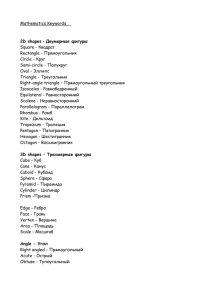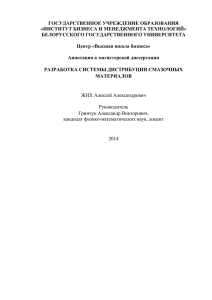sem8Volkov-markedness
advertisement

Олег Волков (volkovolek@gmail.com), 23.01.2015, ВШЭ Ввели в лингвистический обиход Трубецкой и Якобсон в 30х годах У термина очень широкий спектр зачастую несовместимых употреблений Используется всеми – от генеративной грамматики и теории оптимальности до функционалистов, от синтаксиса до фонологии Кажется, что это общий для всех лингвистов термин, нейтральный к конкретной парадигме Кажется, что в некоторых случаях это вообще не термин, а просто полисемичное слово Какие концепты связаны с этим понятием? Что включается в толкование этого слова на бытовом уровне? Оформленность Выделенность Редкость … Как же разобраться? Общие работы по маркированности: [Eckman, Moravcsik, Wirth (eds.) 1983], [Tomić (ed.) 1989] и т. д., но в них обычно нет обзора разных употреблений Конкретные работы по маркированности – over 100500 и они редко проливают на что-то свет Критическая работа с обзором – [Haspelmath 2006] Задача: смотрим на примеры из [Haspelmath 2006] и пытаемся понять: Что в каждом случае значит «маркированность»? Сколько всего вариантов употребления этого термина? Можно ли скомпоновать их в группы? Сколько их получится? Где слово «маркированность» можно без ущерба заменить какими-то другими понятиями? Где маркированность не термин, а просто общеупотребительное слово? 1. “In German, the phonological opposition t:d is neutralized syllable-finally in favor of t, which shows that d is the markbearing member of the opposition.” 2. mark-bearing mark-less voiced voiceless nasalized non-nasalized rounded unrounded 3. «В русском языке “осёл” может обозначать и самца, и самку, а “ослица” – только самку, значит “ослица” более маркирована» 4. “Jakobson (1957[1971:137]) describes the Russian perfective aspect as "concerned with the absolute completion" of an event, whereas the imperfective aspect is "noncommittal with respect to completion or noncompletion" (i.e. unmarked)” 5. “In English, the past tense is marked (by -ed) and the present tense is unmarked.” Верно ли, что в данном случае to mark = ‘signal’, ‘code’, ‘indicate’, т.е. не является термином? 6. “On the scale b > d > g > G, the consonants to the right are increasingly more marked.” 7. “Markedness: the tendency for phonetic terms to be pronounced in a simple, natural way (as determined in part by the nature of speech articulation, acoustics, and audition, and in part perhaps by more abstract cognitive factors—all aspects of the human language faculty).” (Anderson & Lightfoot 2002:101) 8. “A singular/plural pair like book/books is less marked than sheep/sheep ...” Что кроется за этим заявлением? Регулярность – нерегулярность? Можно ли как-либо связать маркированность и иконичность? 9. “The plural category is marked because it requires more mental effort and processing time than the singular” 10. “[t]he marked category tends to be cognitively more complex—in terms of attention, mental effort or processing time—than the unmarked one” [Givón 1991: 337] 11. “For direct objects, coreference with the subject is marked and disjoint reference is unmarked.” 12. “To some extent, we can equate the term 'unmarked' with 'regular', 'normal', 'usual'; and 'marked' with 'irregular', 'abnormal', 'exceptional', or 'unusual'.” (Radford 1988:39) 13. “For marked situations, languages typically use complex expressions.” 14. “For example, Comrie (1986:87) observes for Armenian “a correlation between the formal markedness of the locative construction and the degree of markedness of the locational situation in the world being described”. Armenian can use the simple locative case for ‘in the box’ (tuph-um [box-LOC]), but must use a (formally more marked) postposition for a “less natural” locational orientation such as ‘on the box’ (tuph-i vәra [box-GEN on]).” 15. “The syllable coda position is marked in contrast to the onset position.” 16. На левом краю любой иерархии – наименее маркированная зона, на правом – наиболее маркированная 17. Единственное число не маркировано, множественное – маркировано 18. “Object-verb word order is the marked case: it occurs only with negation.” Похоже ли это на Трубецкого? Можно ли описывать это в терминах нейтрализации? 19. “Absence of noun incorporation is the unmarked case, and the presence of productive noun incorporation has to be triggered by a specific parametric property.” 20. “the unmarked case of any parameter represents the initial hypothesis that children make about the language to be acquired” (Kean 1992; see also Haider 1993:635) Какие смыслы обнаружились у маркированности? Удаётся ли безболезненно избавиться от этого понятия? 1. Trubetzkoyan markedness: Markedness as specification for a phonological distinction 2. Semantic markedness: Markedness as specification for a semantic distinction 3. Formal markedness: Markedness as overt coding 4. Phonetic markedness: Markedness as phonetic difficulty 5. Markedness as morphological difficulty/unnaturalness 6. Cognitive markedness: Markedness as conceptual difficulty 7. Textual markedness: Markedness as rarity in texts 8. Situational markedness: Markedness as rarity in the world 9. Typological markedness: Markedness as typological implication or cross-linguistic rarity 10. Distributional markedness: Markedness as restricted distribution 11. Markedness as deviation from default parameter setting 12. Markedness as a multidimensional correlation: (i) Text frequency (ii) Structural coding (iii) Inflectional differentiation (iv) Facultative expression (v) Contextual neutralization (vi) Typological implication (vii) Iconicity “[The meta-iconic markedness principle:] Categories that are cognitively marked tend also to be structurally marked.” (Givón Markedness involves: (i) Structural complexity: The marked structure tends to be more complex(or larger) than the corresponding unmarked one. (ii) Frequency distribution: The marked category tends to be less frequent than the corresponding unmarked category. (iii) Cognitive complexity: The marked category tends to be cognitively more complex – in terms of mental effort, attention demands or processing time – than the unmarked one. Markedness as complexity Markedness as difficulty Markedness as abnormality + корреляции egg vs. ostrich egg priest/priestess vs. nurse/male nurse plu-en ‘feather’ vs. plu-Ø ‘feathers’ frequency is “an ever present and powerful factor in the evolution of grammatical categories and thus helps in explaining the types of synchronic states actually found” Greenberg (1966:65-69) Частотность в тексте – это не частотность мире вообще Частотность в мире может проявляться частотностью в тексте, но есть ещё масса факторов, её предопределяющих Чем маркированность для лингвиста соблазнительнее частотности? Может ли частотность предопределяться маркированностью? Обратная пропорциональность длины сигнала и его частотности предопределяет возможность нулевого маркирования Наиболее частотные единицы проще для процессинга и усвоения Маркированность как корреляция параметров: базовый параметр – частотность, все остальные ей определяются 1. Markedness as specification for a phonological distinction Detailed phonetic and distributional description 2. Markedness as specification for a semantic distinction Detailed semantic description and pragmatic analysis 3. Markedness as overt coding Overt coding/zero coding 4. Markedness as phonetic difficulty Detailed study of phonetic factors 5. Markedness as morphological difficulty/unnaturalness General principles of mental organization of words (especially frequency differences) 6. Markedness as conceptual difficulty Conceptual difficulty (sometimes due to rarity of occurrence) 7. Markedness as rarity in texts Rarity in texts 8. Markedness as rarity in the world Rarity in the world 9. Markedness as typological implication or cross-linguistic rarity Typological implication, cross-linguistic rarity 10. Markedness as restricted distribution Restricted distribution vs. unrestricted distribution; specifically defined distribution vs. default distribution 11. Markedness as deviation from default parameter setting Deviation from default parameter setting 12. Markedness as a multidimensional correlation Rarity/frequency in texts and its consequences (i) Markedness is represented mentally in particular grammars (ii) Markedness is available in the cognitive code (= Universal Grammar) (iii) Markedness is a metagrammatical concept used by linguists for their convenience (iv) Markedness as an explanatory concept (v) Markedness as a general property of human cultural manifestations (vi) Markedness in a non-technical role

